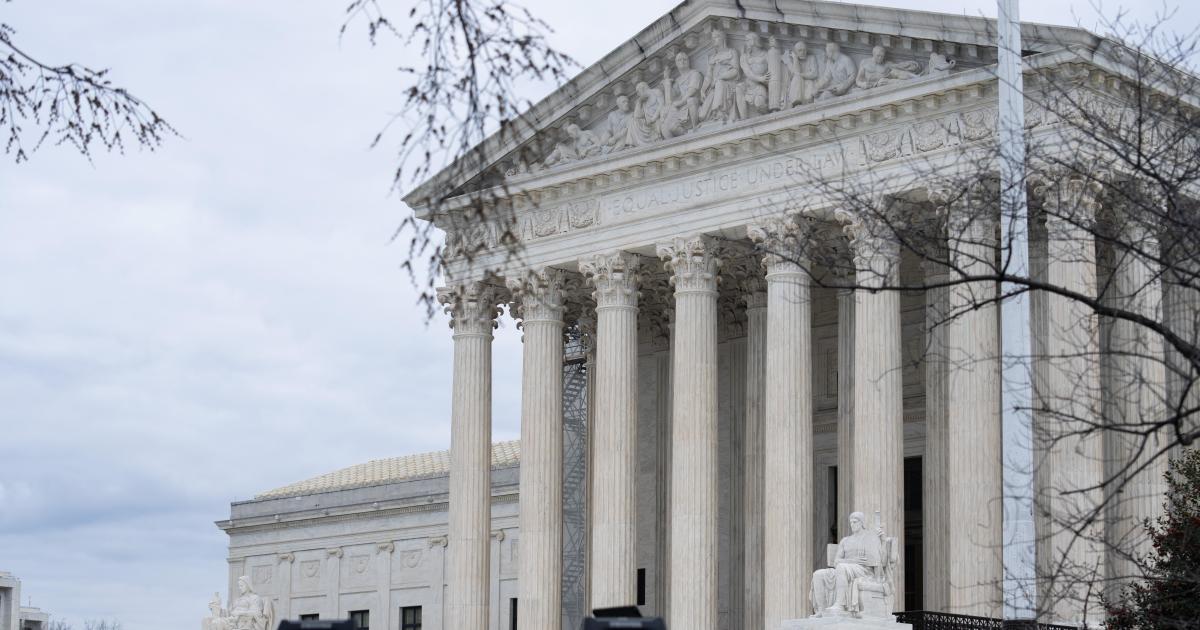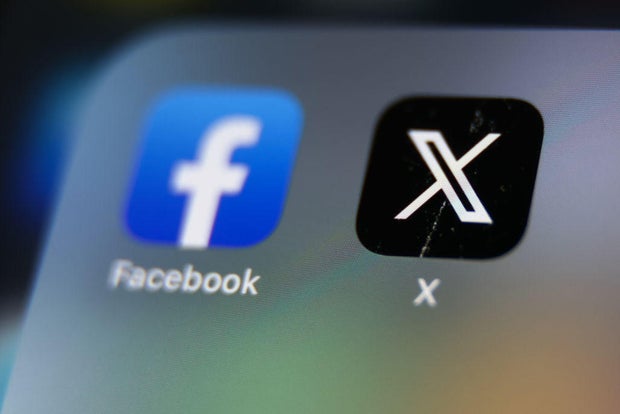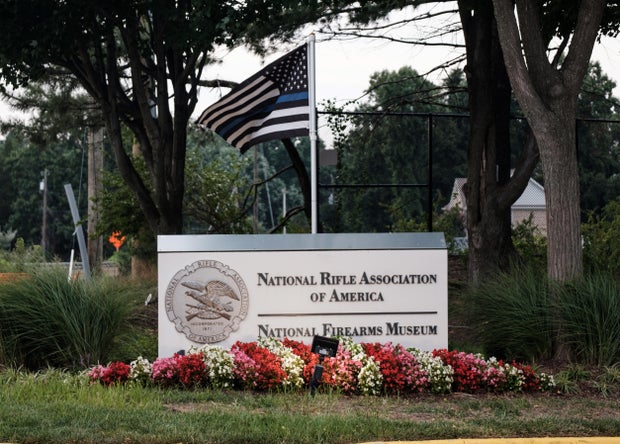CBS News
Supreme Court to hear free speech case over government pressure on social media sites to remove content

Washington — The Supreme Court on Monday will be weighing whether the government crossed a constitutional line into censorship of lawful speech when it pressured social media platforms to take down content it deemed misleading.
The case poses a significant test of the First Amendment’s free speech protections in the digital age and stems from the Biden administration’s efforts to pressure social media platforms to remove content that it said spread falsehoods about the COVID-19 pandemic and the 2020 presidential election.
The Supreme Court is set to consider at what point the federal government’s attempts to protect against misinformation on social media cross into censorship of speech that is constitutionally protected.
“The key free speech issue is how far can the government go in verbally arm-twisting private speech intermediaries to remove speech before that constitutes a First Amendment violation or state action,” said Clay Calvert, a law professor at the University of Florida who is an expert in the First Amendment.
In addition to the social media case, known as Murthy v. Missouri, the Supreme Court on Monday will also hear a dispute over whether a New York financial regulator violated the National Rifle Association’s free speech rights when she pressured banks and insurance companies in the state to sever ties with the gun rights group.
At the core of both cases is so-called jawboning, or informal pressure by the government on an intermediary to take certain actions that will suppress speech. In the first dispute, the intermediaries are the platforms, and in the second case, the intermediaries are insurance companies.
“In both cases, the government doesn’t actually have the power to regulate speech or to decide whether the NRA can access banking institutions or not,” said Will Duffield, a policy analyst at the libertarian Cato Institute, adding that “the government is seemingly gaining, gathering, usurping new powers by leaning on these intermediaries in order to do things that it isn’t authorized to do itself.”
The social media case
The first legal battle before the court arose out of the Biden administration’s efforts to pressure platforms including Twitter, now known as X, YouTube and Facebook, to take down posts about COVID-19 and the 2020 election that it believed spread misinformation.
The dispute was brought by five social media users and two states, Louisiana and Missouri, who claimed their speech was stifled when platforms removed or downgraded their posts after strong-arming by officials in the White House, Centers for Disease Control, FBI and Department of Homeland Security.
Jakub Porzycki/NurPhoto via Getty Images
The challengers claimed that at the heart of the legal battle lies a “massive, sprawling federal ‘Censorship Enterprise'” through which federal officials communicated with social media platforms with the goal of pressuring them to censor and suppress speech they disfavored.
A federal district judge in Louisiana found that seven groups of Biden administration officials violated the First Amendment because they transformed the platforms’ content-moderation decisions into state action by “coercing” or “significantly encouraging” their activities. U.S. District Judge Terry Doughty limited the types of communications agencies and their employees could have with the platforms, but included several carve-outs.
The U.S. Court of Appeals for the 5th Circuit then determined that certain White House officials and the FBI violated free speech rights when they coerced and significantly encouraged platforms to suppress content related to COVID-19 vaccines and the election. It narrowed the scope of the district court’s order but said federal employees could not “coerce or significantly encourage” a platform’s content-moderation decisions.
The Justice Department appealed to the Supreme Court, and the justices agreed to decide whether the Biden administration impermissibly worked to suppress speech on Facebook, YouTube and X. The high court temporarily paused the lower court’s order limiting Biden administration officials’ contact with social media companies.
In filings with the court, the Biden administration argued that the social media users and states lack legal standing to even bring the case, but said officials must be free “to inform, to persuade, and to criticize.”
“The court imposed unprecedented limits on the ability of the president’s closest aides to speak about matters of public concern, on the FBI’s ability to address threats to the nation’s security, and on CDC’s ability to relay public-health information,” Solicitor General Elizabeth Prelogar, who represents the government before the Supreme Court, said.
She argued that senior Biden administration officials were using the bully pulpit to push social media companies to address falsehoods on their platforms, which has never been a free speech violation. As long as the government is seeking to inform and persuade, and not compel, Prelogar wrote, its speech does not run afoul of the First Amendment.
“Influence is also the natural result of successful efforts to inform, to persuade, or to criticize,” Prelogar wrote. “That the platforms often acted in response to the government’s communications thus does not remotely show that those communications were coercive.”
But state officials behind the challenge told the court that accepting the Justice Department’s argument would make the First Amendment “the easiest right to violate.”
White House officials, they said, frequently coupled private demands for social media companies to remove posts with public references to adverse consequences they could initiate, such as antitrust reforms or changes to the law that protect platforms from civil liability over content posted by third parties.
“By silencing speakers and entire viewpoints across social-media platforms, defendants systematically injure plaintiffs’ ability to participate in free online discourse,” state officials from Louisiana and Missouri wrote.
The legal fight is one of five that the justices are weighing in their current term that stand at the intersection of the right to free speech and social media. But in this case, the key question for the justices is whether the Biden administration was engaging in permissible persuasion or unlawful coercion when it urged social media platforms to suppress content.
“It’s going to have to define those rules about what speech is allowed and what’s not, how far can the government go before it violates the First Amendment rights of the individuals who are posting on the speech intermediaries,” Calvert said.
The Biden administration has said it is vital for federal officials to be able to communicate with social media companies on issues of public consequence, and using strong or critical language does not mean it’s crossing a constitutional line.
But David Greene, civil liberties director at the Electronic Frontier Foundation, said U.S. officials will not lose their ability to combat misinformation or disinformation. The government, though, has a responsibility to ensure people don’t perceive it as forcing their hands, he said.
“There are two main issues, and that is what do courts look at to determine whether and at what point a government crosses the line from voicing its opinion about how a social media platform should treat a specific post to unconstitutionally coercing the censorship, the negative moderation of that post,” he said. “There’s no disagreement that there is a point at which it becomes unconstitutional, but what the parties disagree on is what is that line and what is the appropriate analysis for setting that line, what factors to consider?”
Any cases that present close calls should go against the government, Greene said, because officials are “best placed to moderate their behavior to make sure it’s not interpreted as coercive.”
The NRA’s legal battle
In the second case, the court will consider whether the former superintendent of the New York State Department of Financial Services violated the NRA’s free speech rights when she pushed regulated insurance companies and banks to stop doing business with the group.
Superintendent Maria Vullo, who left her post in 2019, had been investigating since 2017 two insurers involved in NRA-endorsed affinity programs, Chubb and Lockton, and determined they violated state insurance law. The investigation found that a third, Lloyd’s of London, underwrote similar unlawful insurance products for the NRA.
In April 2018, after the Parkland shooting, Vullo issued guidance letters that urged regulated entities “to continue evaluating and managing their risks, including reputational risks” that may arise from their dealings with the NRA or similar gun rights groups.
Later that year, the Department of Financial Services entered into consent decrees with the three insurance companies that worked with the NRA. As part of the agreements, the insurers admitted they provided some unlawful NRA-supported programs and agreed to stop providing the policies to New York residents.
Gun control advocates hold a Vigil for Remembrance and Change to honor of the victims of the mass shootings in El Paso, Texas and Dayton, Ohio, and Chicago, Illinois outside of the NRA headquarters in Fairfax, Virginia on August 5, 2019. (Photo by Michae
The NRA then sued the department, alleging that Vullo privately threatened insurers with enforcement action if they continued working with the group and created a system of “informal censorship” that was designed to suppress its speech, in violation of the First Amendment.
A federal district court sided with the NRA, finding that the group sufficiently alleged that Vullo’s actions “could be interpreted as a veiled threat to regulated industries to disassociate with the NRA or risk DFS enforcement action.”
But a federal appeals court disagreed and determined that the guidance letters and a press release couldn’t “reasonably be construed as being unconstitutionally threatening or coercive,” because they “were written in an even-handed, nonthreatening tone” and used words intended to persuade, not intimidate.
The NRA appealed the decision to the Supreme Court, which agreed to consider whether Vullo violated the group’s free speech rights when she urged financial entities to sever their ties with it.
“Allowing unpopular speech to form the basis for adverse regulatory action under the guise of ‘reputational risk,’ as Vullo attempted here, would gut a core pillar of the First Amendment,” the group, which is represented in part by the American Civil Liberties Union, told the court in a filing.
The NRA argued that Vullo “openly targeted the NRA for its political speech and used her extensive regulatory authority over a trillion-dollar industry to pressure the institutions she oversaw into blacklisting the organization.”
“In the main, she succeeded,” the organization wrote. “But in doing so, she violated the First Amendment principle that government regulators cannot abuse their authority to target disfavored speakers for punishment.”
Vullo, though, told the court that the insurance products the NRA was offering its members were unlawful, and noted that the NRA itself signed a consent order with the department after Vullo left office after it found the group was marketing insurance producers without the proper license from the state.
“Accepting the NRA’s arguments would set an exceptionally dangerous precedent,” lawyers for the state wrote in a Supreme Court brief. “The NRA’s arguments would encourage damages suits like this one and deter public officials from enforcing the law — even against entities like the NRA that committed serious violations.”
The NRA, they claimed, is asking the Supreme Court to give it “favored status because it espouses a controversial view,” and the group has never claimed that it was unable to exercise its free speech rights.
A decision from the Supreme Court in both cases is expected by the end of June.
CBS News
Kamala Harris will speak with “60 Minutes” tomorrow. Here’s what to know for the interview.

Voters will get the chance to hear from Vice President Kamala Harris on Monday as she presents her case for why she should be president in a “60 Minutes” election special.
For decades, “60 Minutes” has featured both Republican and Democratic nominees for presidents, but this year, former President Donald Trump backed out after previously indicating he would be on the show. Correspondent Scott Pelley, who’d been set to interview Trump, will instead travel to Arizona’s Maricopa County, home to more than 60% of Arizona’s voters and a critical battleground in a key swing state.
One thing is certain about the election; with the U.S. deeply involved in both the wars in Ukraine and the Middle East, whoever wins on Nov. 5 will become a wartime president.
What Harris will discuss
Israel’s war started one year ago after Hamas launched a surprise terror attack and correspondent Bill Whitaker will discuss the ongoing war with Harris.
Harris will also discuss the economy, immigration, her record as vice president and the differences between herself and Trump.
Democratic vice presidential candidate Gov. Tim Walz will also appear.
Whitaker joined the Democratic ticket on the campaign trail this week to gain insight into their platform’s priorities and values, and what the candidates believe voters should know.
Why Trump pulled out of the “60 Minutes” interview
Leading up to the candidate hour, Trump, through campaign spokespeople, was the first candidate to accept the “60 Minutes” request to be interviewed for the special, according to CBS News. It had been agreed that both candidates would receive equal time during the broadcast.
Trump last sat down with 60 Minutes in 2020. He walked out during the interview with Lesley Stahl. Trump referenced the incident on Tuesday night at a Milwaukee press conference when asked about his decision not to participate in the Oct. 7 “60 Minutes” election special.
“Well, right now, I went to – they came to me and would like me to do an interview, but first I want to get an apology, because the last time I did an interview with them, if you remember, they challenged me on the computer,” Trump said. “They said the ‘laptop from hell’ was from Russia, and I said it wasn’t from Russia. It was from Hunter, and I never got an apology, so I’m sort of waiting. I’d love to do ’60 Minutes.’ I do everything.”
The Republican nominee for president emphasized that he felt he was owed an apology from “60 Minutes.”
“Let’s see if they do it. I wouldn’t mind doing 60,” Trump continued. “I’ve done ’60 Minutes’ a lot.”
In a statement on Tuesday, Trump campaign communications director Steven Cheung said that Trump’s team had not agreed to an interview.
“Fake News,” Cheung said in a post on X. “60 Minutes begged for an interview, even after they were caught lying about Hunter Biden’s laptop back in 2020. There were initial discussions, but nothing was ever scheduled or locked in. They also insisted on doing live fact checking, which is unprecedented.”
Previous Trump, Harris appearances on 60 Minutes
Trump previously sat down with “60 Minutes'” Mike Wallace in 1985, Pelley in 2015 and Lesley Stahl twice in 2016, first in July of that year and then again in November of 2016. He also spoke with Stahl again in 2018 and 2020.
Harris previously sat down with Whitaker last year. She also was interviewed by Norah O’Donnell, “CBS Evening News” anchor and “60 Minutes” contributing correspondent, in 2020.
How to watch the “60 Minutes” election special
CBS News
Kamala Harris discusses U.S. relationship with Israel

Watch CBS News
Be the first to know
Get browser notifications for breaking news, live events, and exclusive reporting.
CBS News
Nature: Aspens in Utah – CBS News

Watch CBS News
Be the first to know
Get browser notifications for breaking news, live events, and exclusive reporting.



